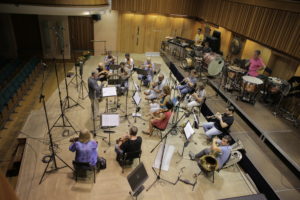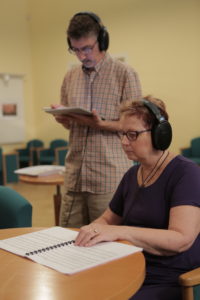The Recording
By Mona Lyn Reese
Thirty years ago, I wrote one of my most popular and most performed works, The Mitten. Friends of the Minnesota Orchestra commissioned this piece in 1986. The Minnesota Orchestra has performed it hundreds of times. The Mitten is also a favorite for the Atlanta Symphony and appears regularly on their children’s programs. The Mitten is a musical story perfect for children’s or family concerts. The narrator tells the story and the orchestra provides the characters.
Why did it take so long for The Mitten to be recorded?
Each time an orchestra schedules school concerts, I got emails and calls from school administrators and teachers asking me for a recording. I have never had one. Never. I had a one-mike audition recording, which means I can use it to get additional performances or commissions, but not give to a teacher. Why not? If this piece had been played and recorded by a community or college orchestra, I would have handed out free copies like candy. However, professional orchestras have controlled performance, recording, and employment contracts with the musicians. Even with the best will in the world, neither group would be able to make a commercial recording for me.
Hundreds of performances and 30 years go by until I meet Bob Lord of PARMA Recordings. PARMA records classical music and, any music really, even the ‘out there’ stuff. “This is a great piece.” he said. “Let’s record with the Moravian Philharmonic Orchestra in the Czech Republic.” It’s easier to record with the MFO than an American orchestra because recording rules and employment contracts are different.
Tom and I headed off to the Czech Republic in September.
The MFO offices, concert hall, and recording studio are right above the Moravian Restaurant. The food is so good, you get a bib.
What’s a recording session like?
The next day we met with our team in the hotel lobby and walked to the hall. The recording equipment is set up in a large room above the hall. A TV and speakers dominate the room. Of course, the composer and recording people have headsets that link directly to the sound stage. The monitors are there for the orchestra manager and other people not directly involved in the recording or performance.
Most of the time, I’m extremely nervous about recording sessions. I’m not used to listening for recordings, I’m more comfortable with performances. I told Bob, “I’ve done tens of recordings and hundreds of performances. I worry about about my ability during every recording session.” This time, I felt a little more comfortable since the piece had had so many performances, but still; listening for a recording is a challenge.
This is Veet. As soon as I started working with him, I calmed down a lot. The MFO has two concertmasters, Veet is one of them. He’s also Parma’s lead engineer on the MFO projects. Not only is he a marvelous violinist and recording guru, he speaks English perfectly. Do I speak Czech? No. Here he is, explaining something and playing Air Violin. I play Air Violin myself, so I understand completely.
An instrument and musical theme portray each animal in the story. The clarinet plays the mouse; a trumpet, the fox; and the tuba is a wild boar. One of the instructions to the tuba player is to “snort” into the horn. “How does he do that?” said Veet. I demonstrated by cupping my hands around an imaginary tuba mouthpiece and snorted. Veet looked skeptical, but gave the instructions. When the player executed the snort, everyone in the orchestra and the booth burst out laughing! It was so funny! Most of the time, we classical musicians are very serious and intense during sessions because we don’t want to waste time and money, we must be professional and not joke around. Bunch of gloomy gusses in the studio. It must have taken 5 minutes for us to stop laughing and get back to work. Here’s a little bit of that take.




